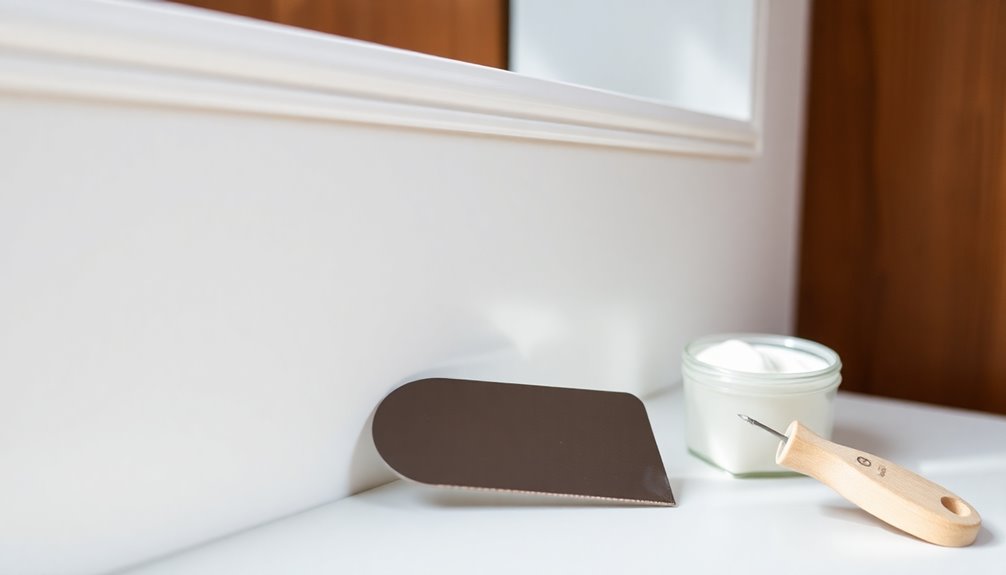To fill nail holes in trim and achieve a seamless finish, start by making sure all nails are flush and the area is smooth. Use a shrink-free spackling compound, applying it with a putty knife at a 45-degree angle. Once it's dried, lightly sand the surface with fine-grit sandpaper to eliminate any imperfections. Don't forget to apply a spot primer before painting to guarantee everything blends perfectly. With careful preparation, application, and finishing touches, your trim will look flawless. Curious about how to perfect those final steps? There's plenty more to explore!
Key Takeaways
- Start by ensuring nails are flush with the trim and remove any raised fragments around the holes for a smooth surface.
- Choose a shrink-free spackling compound or wood filler that can be sanded and painted to ensure a seamless finish.
- Apply the filler with a putty knife at a 45-degree angle, pressing firmly into the holes and scraping for a flat surface.
- After drying for 2-3 hours, lightly sand the filled area with fine-grit sandpaper and clean the dust thoroughly.
- Use a spot primer before painting to achieve consistent coverage and blend with the existing trim for a flawless look.
Preparation for Filling Nail Holes

Before you start filling nail holes in your trim, it's essential to prepare the area properly.
First, check for any protruding nails and use a nail set to hammer them in flush with the trim surface. Inspect for bent nails or staples and pry them up with a putty knife or painter's 5-in-1 tool.
Next, remove any raised fragments around the nail holes using your putty knife to create a smooth surface for filling.
Once that's done, take fine-grit sandpaper (120-220 grade) to smooth the nail holes, ensuring better adhesion for the wood filler.
This preparation helps achieve a flawless paint job, so don't skip these steps before applying the water-based wood filler and addressing any excess filler.
Recommended Fillers and Techniques

When it comes to filling nail holes in trim, choosing the right filler and technique makes all the difference. For a seamless finish, opt for shrink-free spackling compound, which minimizes future dips, or use wood filler that can be sanded and painted effectively.
When applying spackling, use a putty knife at a 45-degree angle to press the filler firmly into the holes, guaranteeing a smooth surface. After allowing the spackling to dry for 2-3 hours, lightly sand the area with fine-grit sandpaper (120-220 grade) for a flush appearance.
Don't forget to apply a spot primer over the filled areas before painting; this guarantees consistent coverage and helps your paint match the existing trim color beautifully. Additionally, using DIY cleaning solutions can help maintain the pristine condition of your trim while you work on your project.
Application Process for Spackling

Start by choosing a shrink-free spackling compound to guarantee the filled nail holes stay smooth over time.
To fill the holes, use a putty knife and press the spackling firmly into each hole at a 45-degree angle. Scrape across the surface of the trim multiple times to achieve a flat finish, then wipe away any excess with a damp cloth.
Allow the spackling to dry for 2-3 hours. After drying, inspect for dips and reapply if necessary to ascertain a flawless finish.
Once satisfied, sand the filled area lightly with fine-grit sandpaper. Finally, apply a spot primer over the spackled areas to ascertain consistent paint coverage before painting for a polished look.
Sanding and Smoothing the Surface

Once the spackling compound has dried completely, it's time to focus on sanding and smoothing the surface. Start by using fine-grit sandpaper (120-220 grit) to gently sand down any excess material until it's flush with the trim.
Be sure to sand lightly and evenly to avoid damaging the surrounding trim, ensuring a seamless blend with the existing surface. After sanding, thoroughly clean the area using a vacuum or damp cloth to remove dust and debris, which can affect paint adhesion.
Inspect the filled areas for any imperfections that may need additional spackling, and repeat the sanding process if necessary. For tougher fillers, consider wet sanding to achieve a finer finish while minimizing dust.
Final Painting and Touch-Ups

After you've sanded and smoothed the surface, applying a spot primer is essential for achieving a consistent finish. This helps the wood fillers blend seamlessly with the existing trim color.
Use a quality paintbrush to apply your paint, and remember that multiple coats may be necessary for even paint coverage on the filled areas.
- Allow adequate drying time between coats
- Clean brushes and tools promptly
- Focus on thorough touch-ups
- Aim for a flawless finish
With these steps, you'll guarantee that all filled nail holes remain invisible after painting. Incorporating natural materials into your decor can enhance the overall aesthetic of your space, making it feel more inviting.
Following these techniques will refresh your trim’s appearance and meet your aesthetic expectations, transforming your space beautifully. In addition to enhancing the visual appeal of your trim, these techniques can also help you maintain its longevity by protecting it from wear and tear. To keep your space organized and stylish, consider implementing the best methods for hanging pants, which can not only save space but also prevent creasing. By combining these strategies, you’ll create a cohesive look that elevates your home while ensuring every element is well cared for.
Frequently Asked Questions
What Do Professional Painters Use to Fill Nail Holes?
Professional painters often use a shrink-free spackling compound to fill nail holes in interior trims.
For wood trim, you'll want to opt for a high-quality wood filler that dries hard and can be easily sanded.
If you're dealing with exterior nail holes, durable caulking is the way to go, as it allows for flexibility.
Remember to slightly overfill the holes and sand them down after drying for a smooth, seamless finish.
Is It Better to Fill Nail Holes With Caulk or Wood Filler?
Imagine a smooth canvas, untouched and pristine. When you're filling nail holes, wood filler's your best friend. It dries hard, resists shrinkage, and sands down to a silky finish.
Caulk might seem tempting, but it's like trying to patch a tire with bubble gum—flexible and prone to imperfections. For a flawless look, grab that wood filler and watch your trim transform into a seamless masterpiece. Your walls will thank you!
What Do Professionals Use to Fill Nail Holes in Trim?
When it comes to filling nail holes in trim, professionals often prefer using high-quality wood fillers or shrink-free spackling compounds.
These options dry hard, resist shrinking, and can be easily sanded for a smooth finish.
You'll find that applying the filler with a putty knife, slightly overfilling the hole, works best.
After it dries, a bit of sanding guarantees it's flush with the trim, ready for a flawless paint job.
How Do You Hide Finishing Nail Holes?
Ever wondered how to make those pesky finishing nail holes disappear? You can hide them easily!
Start by using a shrink-free spackling compound or wood filler. Apply it with a putty knife, overfilling slightly, then scrape it flat for a smooth surface.
Once it's dried, sand it down with fine-grit sandpaper. Afterward, prime the area before painting for a consistent look.
With these steps, you'll achieve a flawless finish that impresses!
Conclusion
Now that you've tackled those pesky nail holes, your trim is ready to shine like a star in the night sky. By choosing the right filler and following the steps to fill, sand, and paint, you've transformed imperfections into a smooth canvas. Just like a skilled artist, you've turned a simple task into a masterpiece. With a little patience and practice, your home can radiate beauty, inviting admiration from all who cross its threshold.









